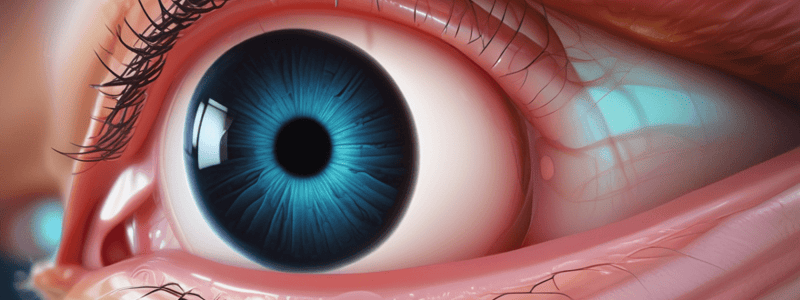Podcast
Questions and Answers
What is the primary location of separation in a retinal detachment?
What is the primary location of separation in a retinal detachment?
- Between the RPE and the choroid
- Between the photoreceptors and Bruch's membrane
- Between the RPE and the NFL
- Between the RPE and the photoreceptors (correct)
Which glycoproteins are responsible for maintaining the adherence of RPE cells to Bruch's membrane?
Which glycoproteins are responsible for maintaining the adherence of RPE cells to Bruch's membrane?
- Hemoglobin and myoglobin
- Collagen and elastin
- Fibronectin and laminin (correct)
- Albumin and globulin
What can occur if photoreceptors do not receive nutrients from the choroid due to fluid accumulation in the subretinal space during retinal detachment?
What can occur if photoreceptors do not receive nutrients from the choroid due to fluid accumulation in the subretinal space during retinal detachment?
- Decreased intraocular pressure
- Rapid regeneration of photoreceptors
- Necrosis of photoreceptors (correct)
- Enhanced visual acuity
Which procedure involves using argon laser for treating retinal detachment?
Which procedure involves using argon laser for treating retinal detachment?
What type of hemorrhages result from the rupture of superficial precapillary arterioles?
What type of hemorrhages result from the rupture of superficial precapillary arterioles?
Which layer of the retina typically contains dot or blot hemorrhages?
Which layer of the retina typically contains dot or blot hemorrhages?
What is the common cause of Retinal Hard Exudates?
What is the common cause of Retinal Hard Exudates?
What is a common association with Cotton Wool Spots?
What is a common association with Cotton Wool Spots?
What is the identifying feature of Boat Hemorrhages?
What is the identifying feature of Boat Hemorrhages?
What is the most common cause of Cotton Wool Spots according to the text?
What is the most common cause of Cotton Wool Spots according to the text?
What is the type of residue seen in Retinal Hard Exudates?
What is the type of residue seen in Retinal Hard Exudates?
Where are Cotton Wool Spots usually located?
Where are Cotton Wool Spots usually located?
Which of the following structures are retinal drusen typically located between?
Which of the following structures are retinal drusen typically located between?
Which condition is associated with the presence of intraluminal plaques, also known as Hollenhorst plaques?
Which condition is associated with the presence of intraluminal plaques, also known as Hollenhorst plaques?
What is the characteristic appearance of myelinated nerve fibers on the retina?
What is the characteristic appearance of myelinated nerve fibers on the retina?
Which of the following conditions is NOT associated with retinal vasculitis?
Which of the following conditions is NOT associated with retinal vasculitis?
What is the characteristic appearance of acute optic disc edema secondary to increased intracranial pressure?
What is the characteristic appearance of acute optic disc edema secondary to increased intracranial pressure?
Which structure is responsible for providing a blood supply to the retina in cases of central retinal artery occlusion (CRAO) with a cilioretinal artery?
Which structure is responsible for providing a blood supply to the retina in cases of central retinal artery occlusion (CRAO) with a cilioretinal artery?
What is the most common cause of boat hemorrhages according to the text?
What is the most common cause of boat hemorrhages according to the text?
What is the characteristic appearance of hard exudates as described in the text?
What is the characteristic appearance of hard exudates as described in the text?
Which of the following conditions is NOT associated with cotton wool spots according to the text?
Which of the following conditions is NOT associated with cotton wool spots according to the text?
What is the primary histopathological feature of cotton wool spots described in the text?
What is the primary histopathological feature of cotton wool spots described in the text?
What is the characteristic appearance of retinal hard exudates according to the text?
What is the characteristic appearance of retinal hard exudates according to the text?
What is the primary cause of the separation between the RPE and the photoreceptors in a retinal detachment?
What is the primary cause of the separation between the RPE and the photoreceptors in a retinal detachment?
Which glycoproteins in Bruch's membrane are responsible for maintaining the adherence of RPE cells?
Which glycoproteins in Bruch's membrane are responsible for maintaining the adherence of RPE cells?
What is the common consequence of fluid accumulation in the subretinal space during a retinal detachment?
What is the common consequence of fluid accumulation in the subretinal space during a retinal detachment?
Which layer of the retina is typically the location of dot or blot hemorrhages?
Which layer of the retina is typically the location of dot or blot hemorrhages?
What is the characteristic appearance of flame-shaped retinal hemorrhages?
What is the characteristic appearance of flame-shaped retinal hemorrhages?
What is the primary cause of retinal drusen according to the text?
What is the primary cause of retinal drusen according to the text?
Which of the following conditions is NOT associated with retinal vasculitis according to the text?
Which of the following conditions is NOT associated with retinal vasculitis according to the text?
What is the characteristic appearance of myelinated nerve fibers on the retina described in the text?
What is the characteristic appearance of myelinated nerve fibers on the retina described in the text?
What is the primary cause of acute optic disc edema according to the text?
What is the primary cause of acute optic disc edema according to the text?
What is the primary source of blood supply to the retina in cases of central retinal artery occlusion (CRAO) with a cilioretinal artery?
What is the primary source of blood supply to the retina in cases of central retinal artery occlusion (CRAO) with a cilioretinal artery?
Flashcards are hidden until you start studying



